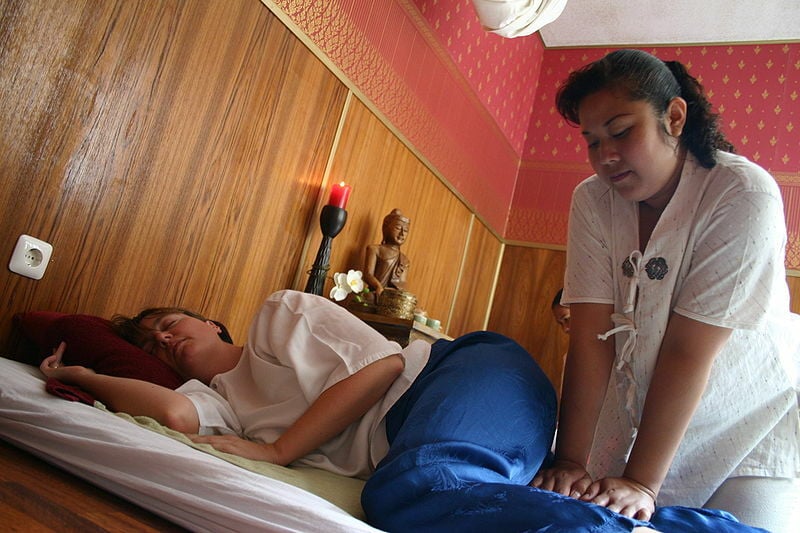The benefits of traditional Thai massage

One of Thailand’s most famous cultural delights is that of a Thai massage. And, it can be said that once you have one of these, you won’t go back to your previous methods of healing and relaxation. Thai massages have been around for 2,500 years as the method began originally as a type of healing art in India, influenced by Ayurvedic and traditional Chinese medicine.
Thai Traditional massages are unique from Western or European massages in that the receiver lies fully clothed on a mat that is usually on the ground or low to the floor.
For a traditional Thai massage, the masseuse will stretch and pull your limbs while using rocking motions to relieve stress, and improve flexibility and circulation, leading to the inevitable deep relaxation felt by most who have undergone this Eastern‐style massage. Thai massages focus more on the flow of energy, or chi, throughout your body which is much more in line with Asian healing arts.
The energy, or chi, is thought to move through one’s body along pathways known as sens. Sens correspond to different parts of the body, such as the bones, muscles, blood, and nerves. The sens that affect the mind and consciousness are thought of as more subtle channels.
One reason Thai massages focus on the sens, is that practitioners believe that tight muscles cause blockages within different Sen. Such blockages are believed to reduce the flow of life energy, which can cause stiffness resulting in illness. Thai massage therapists employ different techniques that either open or tighten different Sen lines to correct the flow of life energy.
Although it may sound like a Thai massage may not fix the body, scientific studies have indicated that this myth is incorrect as aches and pains have been known to go away after using this type of therapy. Health issues as migraine headaches, back pain, and joint pain have all been treated successfully by undergoing Thai massage therapy.
Also, researchers concluded that the benefits of using this non‐pharmaceutical type of treatment may ease symptoms for up to 15 weeks. Researchers have also indicated that a Thai massage increases flexibility as it can improve blood flow and oxygen supply to muscles. Thai massage can promote the circulation of both blood and lymph through the use of gentle stretches. The increased circulation then fills the body’s tissues with oxygen. This helps promote cell growth and heart health. It is scientifically known that improved blood circulation stimulates the somatosensory system. This system plays a major role in balance.
For those patients who have anxiety, Thai massages can decrease anxiety while providing a sense of calm and relaxation. Such studies have shown that those who receive the massage, test lower on psychological assessments for stress afterwards. Brain scans have also shown the same results, even beating out traditional forms of physical therapy to treat anxiety. A 2015 study also found that Thai massage significantly reduces levels of a certain stress marker present in the saliva, called sAA.
Since Thai massages incorporate yoga‐like stretching, receivers often report feeling rejuvenated with energy. One small study revealed that between Thai and Swedish massages, the Thai massages left people feeling more energised and renewed. But the researchers of that study do say that there needs to be more research to make a concrete conclusion.
In a traditional Thai massage, practitioners use their hands, thumbs, elbows, forearms, and sometimes even their feet to reduce tension in your muscles. The masseuse may even sit on you to aid in helping you stretch into certain positions. A Thai massage involves the recipient also doing a bit of work as it involves more intense stretching. This method is different to the method used in Swedish massages, as oil and deep kneading are instead used, while the recipient lays still.
After a Thai massage, a person may feel very relaxed, however, it is important to note that muscles have been stretched, worked, and prodded. After a Thai massage, a person should rest and drink plenty of water. There are no set guidelines or recommendations for how often a person should get a Thai massage.
But, it is important to avoid a Thai massage when recovering from an injury as the physical intensity of the massage can cause further injury to the body.
Because Thai massage has profound effects on your circulatory system, make sure you check with your doctor before you schedule a massage, especially if you have: diabetes, open wounds, underwent surgery recently, cancer, are pregnant, heart disease or coronary artery disease, conditions that affect your spine, osteoporosis, high blood pressure, deep vein thrombosis, neurological disorders, burns, bleeding disorders, or thrombocytopenia.
While this list is not conclusive, it is important to consult a physician if you have any underlying health issues before getting a Thai massage to minimize the risk of harm.
Latest Thailand News
Follow The Thaiger on Google News:


























